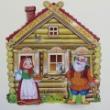|
Back in 2003, when computer animation just appeared on the big screens, fascinating with its bright and colorful picture, the animated film “Finding Nemo”, the fifth cartoon of the famous studio Pixar, which was distributed by Company, came out. "Finding Nemo" received a lot of audience enthusiasm and became one of the first animated films that won the Oscar.
The cartoon tells about the problems in a small family of clown fish, consisting of Marlin's father and his son Nemo. Because of his disobedience, Nemo falls into the hands of scuba divers and as a result finds himself in an aquarium. The main part of the cartoon consists of the search by Marlin of his son Nemo, in which he is helped by an forgetful fish named Dory. Over the course of the story, all participants experience unprecedented adventures. In the end, the family of Marlin and Nemo is reunited, and the problems and misunderstandings in their family are replaced by love and cooperation.
What does this cartoon teach?
The parent is not a standard, but one who can be wrong (+/-);
weakening of the authority of parents in the eyes of the child (-).
At the beginning of the cartoon, we meet the family of clown fish as it was before the main events of the cartoon. Marlin was married to a fish named Coral, and a happy couple was expecting the birth of a whole offspring. However, near their reef was a predatory fish barracuda and attacked their family. Marlin tried to fight back, but lost consciousness from the blow of the enemy. When the hero came to his senses, his wife was no longer alive. Like all of their children-eggs, except for one, from which the main character of the story emerged, Nemo. In view of the terrible tragedy that occurred with the family, Marlin swore to himself always to protect his only son.
In one of the episodes, Nemo and his friends run away from the teacher and swim up to the very edge of the reef. There, the guys see the boat and arrange a dispute, who is closer to her swim. Diving, Sequin and Shelfik make their move, and only Nemo remains. He hesitates and says that his father forbade him to swim beyond the reef, as it is dangerous (Marlin swore to always protect Nemo - that's why he is so hyper-careful and hyper-caring) At this point, Marlin accidentally appears at the company and, of course, rushes to his son with reproaches that he was going to disobey him. Nemo explains that it is not. Friends first supported him, but in the end they added: “He just chickened out ...” It hooks Nemo, he disobeys Marlin, and directly in his eyes defiantly floats to the boat. Nemo swims so close that it even touches her. Marlin is afraid to swim behind him and in anger screams for him to return, and promises to scold him well.
Suddenly a scuba diver appears near the boat and catches Nemo. Marlin is completely helpless in this situation, he tried to save his son, but a second scuba diver appeared who photographed Marlin, and he, blinded by the flash, completely lost his orientation in space. Recovering, he only saw the trail from the motorboat, which went to Sydney.
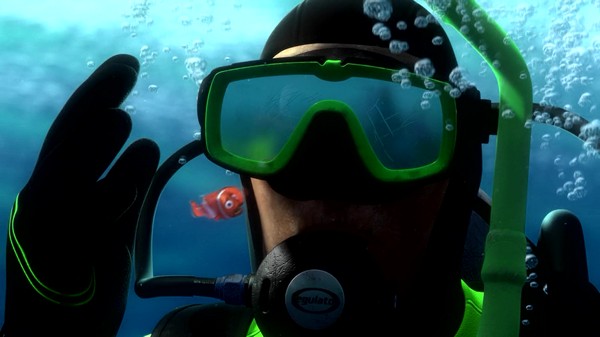
Thus, Marlin is set before the task - to find his son. And in order to find him - he needs to change. It turns out that his cowardice and caution hinders both himself and his son.
Of course, life shows that not all parents are perfect, and many should really work hard on themselves in order to properly raise their children. At the same time, in the minds of young children, parents are always the basic benchmark and guideline in shaping their ideas about the world around them. If, from an early age, the idea that his mom and dad "can be wrong" is laid in the child's mind, then in essence his system of values is destroyed, as the ideal disappears from it. At a more adult age, when the consciousness is already sufficiently developed, a person is able to form righteous ideals not confined solely to his family and his ancestors, to adequately perceive the imperfection of parents, learn from this lesson and try not to repeat the “generic” mistakes in his life. But here we are talking about the best adolescence at best. And the official age limit of the cartoon considered in this review is “0+”.
There is another important nuance that becomes clear when assessing the idea of “imperfect parents” in conjunction with the political realities of today. We are talking about the promotion of juvenile justice, both in the West, where this process is almost completed, and in Russia, where the events are “in full swing” (http://rvs.su/chto-takoe-yuvenalnaya-yusticiya/opisanie-yavleniya ).
Since the cartoon very strongly focuses on the shortcomings of the father and that the parent is changing not just for the sake of his child, but also with his giving, the scene where Nemo gets to scuba divers before Marlin’s eyes can be interpreted as an image of the confiscation of a child from a negligent parent. Marlin is depicted as a “bad” parent, which is why he is losing a child. He hindered his son with his shortcomings - which led their small family to such an intermediate result. It is also interesting that Nemo is taken exactly at the moment when Marlin scolds him. Marlin at the beginning of the story is a hidden image of an imperfect parent, "worthy" of the deprivation of a child.
Such a motive of an imperfect father, dependent on the will of the son and losing him until he eventually changes in the direction of the son’s wishes, is a full reference to juvenile justice promoting the breakdown of the natural hierarchy of “parent-child”. Juvenile justice, the child, his rights and will are placed above the parent. The image of this is present in this cartoon - because the actions of Nemo, the son, determine the fate of the father.
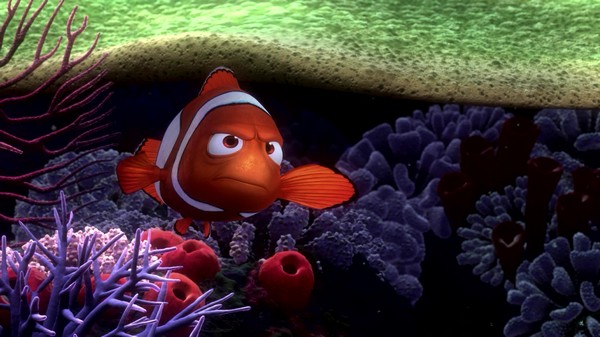
True, it is worth mentioning that the harmful family morality of the cartoon significantly softens the fact that Nemo also has to work hard and work on himself after he initiates a split with his father, and also that the relations in the family of clown fish are very convincingly changing into a positive side at the end of the story.
Other Family Images (-)
By the middle of the cartoon, we also become acquainted with another family - the family of sea turtles, again consisting of father and son (another image of an incomplete family). Father's name is Crash, and his son - Son. The relationship between them is depicted well and harmoniously, which is the complete opposite of the relationship of Marlin and Nemo. Having met this family, the clownfish perceives it as a standard and decides that it was not worth being so strict with Nemo. Acquaintance with the family of turtles becomes a turning point in Marlin's mind, after which he decides to change once and for all.
The image of this family spoils not only its incompleteness, but also the “youth slang” in which they communicate. Almost every second word that the father, the son say the word "dude." Also in their vocabulary there are words: fly away, kickback, cool, prikolchik, mini-man. Instead of the word "head" - the word "turnip". Well, and the most important thing - with the name of his child, Crash decided not to bother at all and called him “Son”. Here is such a "reference" family.
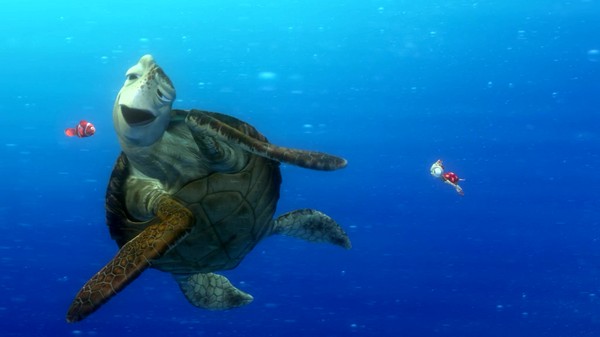
Superiority of a woman over a man (-)
In the friendly relations between Marlin and Dori there is a clear superiority of the female image over the male one. This concerns the correctness of decision-making, behavior in a given situation and personal qualities.
This can be traced in the following episodes:
- Marlin is very frightened by meeting with vegetarian sharks and believes that this is some kind of trap. The hero trembles and fears any sudden movement. Dory behaves exactly the opposite. In the episode with the sharks, she is calm, benevolent, expresses her opinion and support. It is possible that because of her sclerosis, she completely forgot who the sharks are and what they feed on. Nevertheless, the fact remains that the male character in the scene of potential danger is scared and trembles, and the female one is calm and confident.
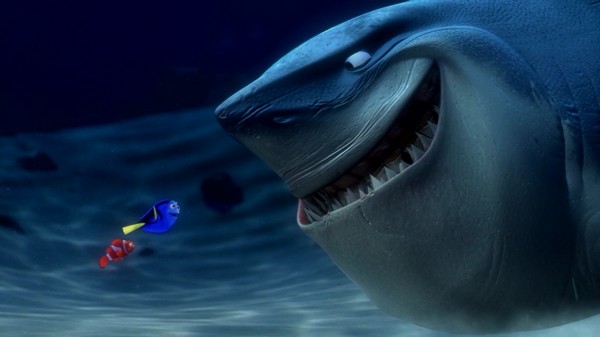
- In one of the episodes, Marlin finds a mask for swimming, which contains the address of the diver who caught Nemo. Carelessly, the mask falls deep into the abyss. Marlin is very upset, he is afraid of the depth in which the total darkness reigns, and almost resigns himself to the fact that he will never see his son again. Dory again behaves opposite of Marlin: “Hey, mister, do you know what you should do? Everything down and down, everything down and down. Floated! ”Dory calmly, even with a kind of enthusiasm and joy, goes to the bottom of the abyss. With her optimistic attitude she instills strength and confidence in Marlin, and he follows her. Of course, this can also be viewed as a positive point: the friendship between two fish is depicted, and one does not give way to the other. But from the point of view of the male and female image in the cartoon, the same picture is obtained. The female image is endowed with courage, optimism, decisiveness, and the male image with cowardice, passivity, and uncertainty. The woman is courageous and placed above the man.
- On the way to Sydney, the heroes get lost and decide to ask the way from the school of silver swallow fish. They help them, Marlin thanks them and quickly swims in the indicated direction. Dory lingers a bit - and the school of fish manages to warn her that there will be a cleft of two reefs ahead, and she will have to swim between them, and not over them. Dory, however, immediately forgets that the fish told her, and when she and Marlin swim to the cleft, she simply intuitively says that it is worth swimming between the reefs. She does not remember where this information came from, and this does not seem to Marlin to be the right thing to do. The cleft looks gloomy and intimidating, Marlin assumes that there is a danger waiting for them, and therefore it is necessary to sail from above.
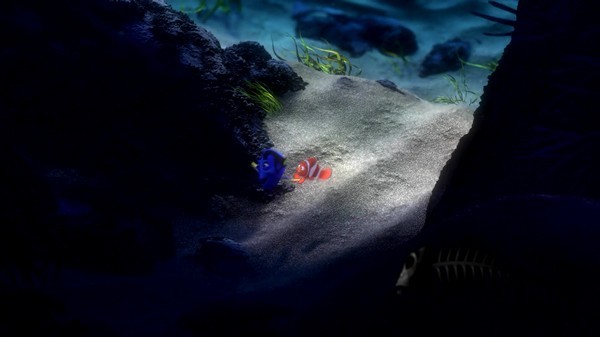
- Dory is unable to convince Marlin, and therefore out of despair floats behind him. On top of them is surrounded by a large school of jellyfish. Clone jellyfish bites do not cause pain (but still paralyze the nervous system), and Dory is in real mortal danger (to die from pain shock). Jellyfish sting Dory, she loses consciousness, and Marlin has to pull her out. Marlin, like a true hero, struggles out of her stinging tentacles, saving her own life and Doreen. This is a very positive example of a real male act, but ... Obviously, since the correctness of the decision about making a path was given to a female character, the image of a man in this situation leaves much to be desired again. Despite the heroic deed of Marlin, the viewer's attention is also focused on the fact that if he listened to Dory, everything would be fine. Again, a woman is superior to a man.
- On the way to Sydney, our heroes see a big, dark, mysterious fish in the distance. Marlin says she is dangerous. Then this fish begins to make some sounds, and Dory realizes that this is a whale. She says that she knows the "whale" language (although how does a sclerosis fish know a foreign language?), And that she can ask him for help and find out the way. Marlin objected (he is afraid that the whale can eat them), but he looks at Dory’s scar left by the jellyfish that she’s got him to blame and gives Dory a decision. Dory enters into dialogue with the whale, as a result he provides them with invaluable assistance.
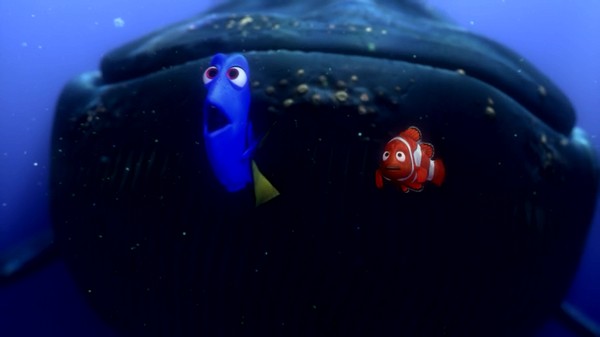
The cartoon promotes a clear superiority of a woman over a man, which is a false premise and fosters in the viewer a corresponding false understanding of the sexes: female as supposedly naturally superior, endowed with courage, activity and other male traits, and male as weak and subordinate.
Education destructive tolerance (-)
Another worth noting is the episode where Marlin and Dory meet with predatory fish.
Three friends (two sharks, the Hillock and Chawk and the hammerfish Anchor) are trying to lead an “insipid” way of life (that is, being vegetarians). They do not eat other fish and learn to treat them friendly. One "vegetarian" from this company says that she has not eaten fish for three weeks. And while our heroes stayed with the predators, Dory’s fish accidentally broke his nose, and when blood began to flow, everything fell into place. One of the sharks (Hillock), smelling the smell of blood, immediately attacked the fish.
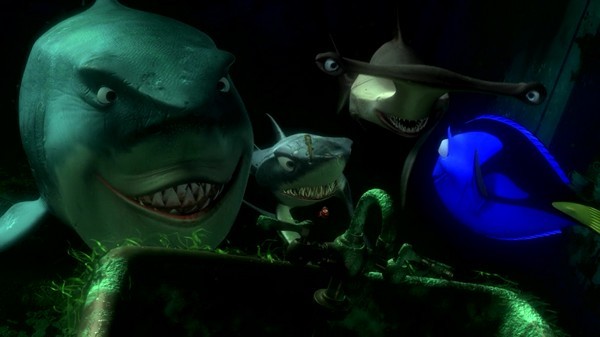
The other two predators began to restrain the "brutalized" comrade (strange, why? Did they have a problem with the smell? According to the logic, they also had to throw at the fish). Marlin and Dory manage to escape from the shark, and you might think that the viewer will not see them anymore, but ... But they appear at the end of the cartoon. Hillock, Chawk and Anchor spend Dory to the house (to Marlin), after their next meeting. Predators are again depicted as absolutely calm and not thirsty to feast on fish.
The images of these predators are twofold. On the one hand, it is shown that “you cannot trample against your nature” (the instincts laid down by nature cannot be suppressed). But it is obvious to almost every child. After all, almost everyone, in childhood, parents show and tell that cats are born kittens, dogs have puppies, and a sheep eats grass, a wolf eats sheep. And the opposite can not be. The cat will not give birth to puppies, and the wolf will not start eating weed. But on the other hand, why do directors portray sharks that eat algae when, by nature, they feed on fish? In the beginning we see a “non-predatory” predator (unnatural), then it becomes a “predatory” (natural), and at the end of the cartoon - again “non-predatory” (non-natural). Those. here the idea is being advanced that nothing is impossible in the world - “sharks may not be insubstantial”. Getting into the head of a child, such a message can develop in him a “tolerance” (calm attitude) towards abnormality.
Let's wind off time for 13 years ahead and look at (which is also unnatural).
Positive role models for the child - the heroes of Nemo and Gill (+)
Consider how the main character of the cartoon, Nemo, behaved and what he did when he got into captivity in an aquarium.
First, once in a new place, Nemo panics. He is just scared, tossing from side to side, and from fear calls his dad. By negligence Nemo gets into the filter (oblong, plastic tube, lowered into the aquarium). The filter starts to suck him in, Nemo calls for help. Here all the inhabitants of the aquarium immediately appear: Nigel, Bulk, Jacques, Peach, Bubble, Breeze, Grotto and Gills, which appears last. The gills, like Nemo, was born and lived in the ocean, until it was caught and placed in an aquarium (all the other fish in the aquarium are shop). Gills depicted serious, strong and purposeful.
Being in the filter, Nemo says that he cannot get out of it, complaining about his underdeveloped fin (one fin is smaller than the other), he asks for help. Fish are ready to help, but the Gill interferes:
- You got there yourself, get out of it yourself.
- But I have one fin less than the other.
- So what? It did not bother me.
And defiantly sails past Nemo, showing his, similar, damaged fin. Seeing this, Nemo is inspired, begins to listen to the command of the Zhabra, and successfully gets out of the trap.
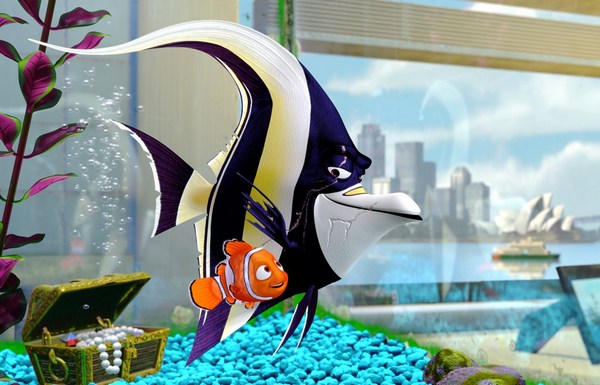
This action is an unconditionally positive behavioral pattern. This is a prime example of the fact that panic in emergency situations is your main enemy. And nothing is impossible, even if you have physical abnormalities, the main thing is to believe in yourself and your strength.
In another action, when the next plan of Gill to escape from an aquarium turns out to be a failure, Nemo is already depicted not as a frightened and helpless, but rather purposeful and self-confident boy. During his time in the aquarium, Nemo grew (developed) spiritually, adopting the best qualities of the Gill. As a result, against the background of all the fish in the aquarium that have lost heart, Nemo tries once again to bring the Gill plan to life, and the second attempt turns out to be successful.
Toward the end of the cartoon, when Marlyn and Dory swim up to Sydney, they meet the pelican Nigel, who delivers them straight to the aquarium where Nemo is. Through the window of the dentist's office, Marlin sees Nemo and tells Nigel to help out his son, and the pelican flies right into the dentist's office, and the war begins. Nemo is unconscious near the sink. Gills sees a chance to save him. With the help of other fish, the Gill manages to jump out of the aquarium, and push Nemo to the sink. Through the drain Nemo is free in the ocean. Gill, like Nemo, most wanted to go back home. But he made a promise that helping Nemo was his first priority. He also promised the fish in the aquarium that they would leave this glass box only all together (they managed to get free at the very end of the cartoon). Each of these promises he kept. Gills puts other people's interests above their own. He is a great example for young viewers..
In parallel with these events, Nigel is pushed out of the office and close the window, and Marlin realizes that he can no longer see his son. He does not notice that his son manages to "slip away" into the ocean.
Marlin was desperate, he thanks Dory for helping him get to Sydney, but now it's time to go home and it's time for them to leave. Dory, in her upset feelings, swims away in the opposite direction and meets Nemo. Then they catch up with Marlin and the long-awaited meeting of the father with the son takes place.
But the joy of meeting father and son does not last long - Dory, along with herring school, gets into the fishing net. During the time spent in the aquarium, Nemo learned from Gill that strength in unity (cohesion). Nemo realizes that with the joint efforts of all the fish, you can break the net, but for this you need to swim down all at once. He swims inside the net and talks about this to the fish, and the net successfully comes off the ship. This is one of the most emotional scenes of the cartoon.
Nemo and Dory are rescued, and all three are successfully returning home.
Then we are shown how the relations in the family of the clown fish have changed. Now Marlin is energetic, enthusiastic, ready for adventure and free from fear of danger. Seeing how dad changed, at the end of the cartoon Nemo says: "Dad, I love you."
Motives for the protection of the natural environment (+)
It is also worth noting, as in the cartoon, how a person’s attitude to wildlife is depicted. Most fish (shop) in an aquarium look clearly unhealthy (one, like a crazy swims and catches the bubbles, the other talks to his reflection, and the third, in general, eats his feces). And the Gill entirely reflects with its appearance sadness and longing for its home. These features of the fish well demonstrate that animals are not designed to be "decor" in the house of man. The animal is not created to be a servant of man, it is freedom-loving, like all living creatures on this planet.
The heroine Darla (the dentist's niece) is remarkable in that, through which the suffering of animals due to mistreatment is clearly demonstrated. Nemo should have been presented to her on her birthday. For eight years, Darle, an eight-year-old girl, has been presented with fishes. But donated pets do not have time to live a few days. She treats them like inanimate toys, which is why they die.
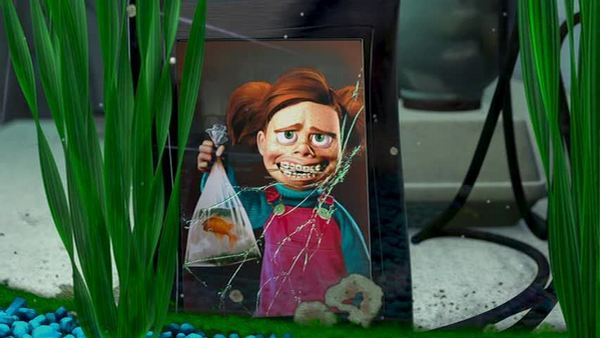
All these moments make you think about how people behave in relation to wildlife.
The film was released in the US and Canada on May 30, 2003, August 27, 2003 in Australia, October 10, 2003 in the UK. It is the fifth Disney / Pixar film and the first to be released in the summer season.
The film collections exceeded all expectations: until the release of Shrek 2 in 2003, Finding Nemo was considered the highest-grossing cartoon in history and was among the top ten highest-grossing films of all time. In the United States alone, more than 28 million copies of a DVD with a cartoon have been sold, which is the record result in history.
After the success of the 3D version of "The Lion King" Disney began to actively improve the highest-grossing their films. And the second of them was “Finding Nemo”. https://www.youtube.com/IgraMultik CHANNEL WITH DEVELOPING GAMES (SMEARKS, MASHA AND BEAR, LUNTIK AND MUCH MORE) *** The cartoon "Finding Nemo" - see ...
At present, it is planned to create a sequel by 2015 called “Finding Dory”.
- A sequel will be released on November 25, 2015 - “Finding Dory”.
- The name "Hillock" for the white shark is not chosen by chance. In the original, this character is called "Bruce": this is exactly the name of the mechanical model of a shark made for the filming of Steven Spielberg's Jaws.
- The scene with the seagulls is a parody quote from Alfred Hitchcock's “Birds”.
- The film was dedicated to Glenn McQueen (en Glenn John McQueen), an animator for Pixar, who died of melanoma in October 2002, seven months before the release of the movie.
- Originally, composers Denny Elfman and Hans Zimmer were considered for writing music.
- In the film, you can find characters from other Pixar films: for example, Planet Pizza truck and Buzz Laiter from Toy Story (1995), Bu fish from Monster Corporation (2001) or Luigi car from future Wheelbarrows, as well as the car "Uncle Topolino" from the future film "Cars 2" (2011). However, this is just a coincidence. In addition to the truck "Planet Pizza", which pixarovtsy add to all their cartoons.
- The dentist's office was modeled on the model of a real dentist's office located in the same building as Pixar.
- In the English version, Breeze (Deb )'s sister (reflection) is called Flo. This is a direct hint of the character of the future film “Cars” and “Cars 2”.
- Girl Darla got her name in honor of producer Pixar Darla C. Anderson.
- One of the boats is named after Pixar sculptor Jerome Renft.
- Forgetful Dory calls Nemo with the following names - Elmo, Fabio, Bingo, Tito, Chico (alluding to the character in the movie “Cars” by Chico Hicks), Harpo and Emo.
- At the end of the credits, Mike Wazowski swims from the monster corporation cartoon. Just before the release of the film, Nemo's toy is present in the previous film.
- In the scene, when a pelican arrives with Marlin and Dory, there is a moment where a boy sits with his mother at a dentist’s reception and reads a comic about Mr. Exclusive from the future cartoon The Incredibles.
- Wallaby Street is named after a graphic design agency on Sydney Commonwealth Street.
- In one of the splash screen ads Moldovan TV channel "Jurnal TV" in the aquarium was a clown fish Nemo.
Roles voiced
| Role | Actor (actress) | Russian dubbing |
|---|
| ocean dwellers |
|---|
| Nemo
| Alexander Gould | Fedor Mashanov |
| Marlin
| Albert brooks | Jan Tsapnik |
| Coral
| Elizabeth Perkins | Julia Rudina |
| Dory
| Ellen DeGeneres | Elena Shulman |
| Crash
| Andrew Stanton | Valery Kukhareshin |
| Prysk
| Nicholas Bird | Ilya Sergeev |
| Mr Skat
| Bob peterson | Alexander Lushin |
| Knoll
| Barry Humphreys | Alexey Travin |
| Anchor
| Eric Bana | Gennady Smirnov |
| Chomp
| Bruce spence | Yevgeny Ganelin |
| Ted
| Jordan renft | Anton Smola |
| Pearl
| Erica Beck | Elizaveta Zakharyeva |
| Shelf
| Eric Per Sullivan | Ivan Chaban |
| Fish school
| John Ratzenberger | Boris Smolkin |
| aquarium inhabitants |
|---|
| Gill
| Willem Dafoe | Victor Kostetsky |
| Bubble
| Brad Garrett | Alexey Guriev |
| Peach
| Allison jenny | Maria Kuznetsova |
| Grotto
| Austin Pendleton | Valery Zakharyev |
| Bulk
| Stephen Ruth | Roman Ryazantsev |
| Breeze / Calm
| Vicky lewis | Svetlana Repetina |
| Jacques
| Joe renft | Sergey Parshin |
| people |
|---|
| Darla Sherman
| Lulu Ebeling | Varvara Chaban |
| Philip Sherman
| Bill hunter | Stanislav Kontsevich |
| other characters |
|---|
| Nigel
| Jeffrey rush | Vladimir Maslakov |
Cartoon characters
- Nemo (en Nemo) - clownfish, son of Marlin
- Marlin (en Marlin) - clownfish, father Nemo.
- Coral (en Coral) - clownfish, Marlin's wife, Nemo's mother.
- Dory (en Dory) - blue surgeon, Marlin's friend and girlfriend Nemo
- Nigel (en Nigel) - American brown pelican, a friend of fish living in the dentist's aquarium. Often flies to the window of the office where the dentist works, but the latter in turn repeatedly expels him. Very good-natured. Helps Marlin and Dory to find Nemo.
- Gill (en Gill) - Moorish idol who dreams to escape from the aquarium. At the time, hurt his fin.
- Bubble (en Bloat) - hedgehog fish.
- Peach (en Peach) - starfish, able to read.
- Grotto (en Gurgle - murmur) - purple is =: en: Royal gramma, hates dirt and germs.
- Bulk (en Bubbles - bubbles) - there is =: en: Yellow tang, which loves bubbles.
- Breeze (en Deb) - is =: en: Dascyllus melanurus. She thinks that the reflection in the aquarium is her sister Stiel (en Flo).
- Jacques (en Jacques) - is =: en: Lysmata amboinensis. Loves cleanliness. He speaks with a French accent.
- Crash (en Crush) - 150 year old loggerhead.
- Prysk (en Squirt) - the little turtle, the son of Crach.
- Mr Skat (en Mr. Ray) - spotted eagle. Teacher of the underwater school where Nemo is studying.
- Knoll (en Bruce) is a white shark-vegan who is friends with fish.
- Anchor (en Anchor) - a vegetative fish bronze hammer, a friend of Bugr and Chawk.
- Chomp (en Chum) - mako-vegeterian, friend of Bugr and Anchors.
- Ted (en Tad) - is =: en: Forcipiger flavissimus. friend Nemo
- Pearl (en Pearl) - is =: en: Flapjack Octopus. girlfriend Nemo
- Shelf (en Sheldon) - seahorse. friend Nemo
- Darla Sherman (en Darla Sherman) is an eight-year-old girl and the main antagonist of the cartoon.
- Philip Sherman (en Philip Sherman) - Sydney dentist and kidnapper Nemo.
Bright blue fish-surgeon, cheerful, kind, having a light character. She is Nemo's best friend, she talks a lot and is not always attentive. Dory had forgotten a lot before. Now she had real memory lapses, she became restless at night. She had previously thought about her parents, and now more and more often children’s memories have come to her, in which much resembled the coast of California and members of her family. Each time the name of the clinic “Pearl of Morro Bay” popped up. And now she wants to know who her relatives are and what connects her to that place. In the Russian dubbing, Dory was voiced by Elena Shulman.
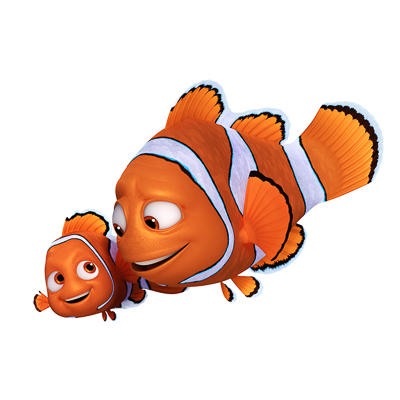
Contrast-colored red-white clown fish living in sea anemone. They are very attached to their place of residence, but have a strong and courageous character. Nemo is naturally friendly and curious, like any teenager. Although he has grown over the year, his caring father Marlin is still next to his son. He tirelessly looks after him and Dory. Despite the sedentary lifestyle, dad and son will be forced to go on the run with Dory to help her remember everything. Nemo was dubbed by George Klopov, and Marlin was voiced by Konstantin Karasik.
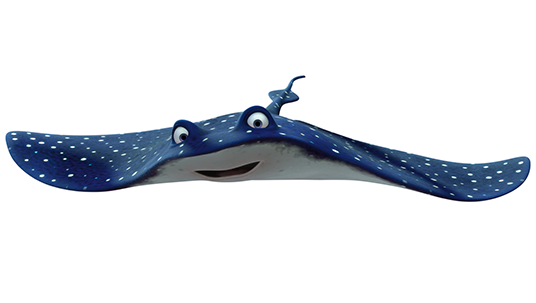
A representative blue-white stingray from the family of spotted eagles. Is a school teacher Nemo. His name is Mr. Ray, he is the smartest fish in the reef area. I am sure that learning should be fun and positive, then the result will be wonderful. He likes to invent learning games for his underwater school students and sing songs. Voiced by character Daniel Shcheblanov.
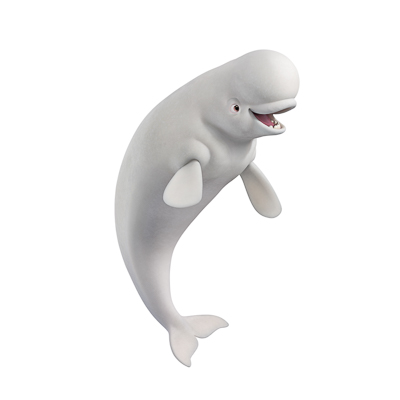
A white whale, or a cute toothy whale, more like a dolphin, is a patient at the California Pearl Morro Bay Rehabilitation Center. He needs a special medical care - setting up his hydroepholocator. And while he is not in tune, Bailey doesn’t like it when they touch him. Able to make funny sharp cries. Voiced by beluga Diomid Vinogradov.
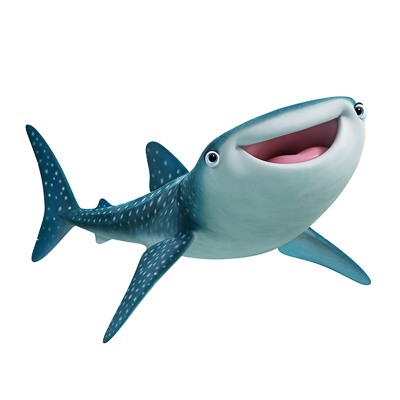 Fate is a peaceful whale shark, a patient of the same California medical center. Dory's old friend, but about her the main character has only fragmentary memories. The shark is experiencing difficulties - it cannot swim straight and therefore feels clumsy. In the clinic, she will certainly have to recover from her illness. Sophia Anufrieva voiced her. Fate is a peaceful whale shark, a patient of the same California medical center. Dory's old friend, but about her the main character has only fragmentary memories. The shark is experiencing difficulties - it cannot swim straight and therefore feels clumsy. In the clinic, she will certainly have to recover from her illness. Sophia Anufrieva voiced her.
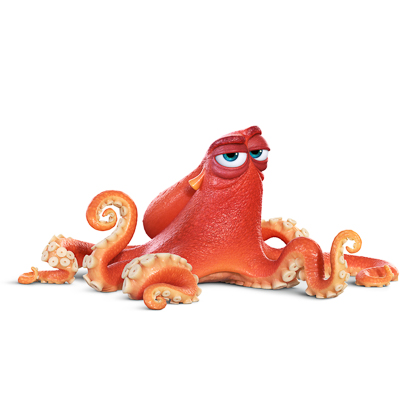 Hank, a red octopus with cold blue eyes, is just a terrible character, although he is very smart. He can never restrain himself from talking to anyone. Oddly enough for a marine inhabitant, Hank is a big coffee lover. And he is very freedom-loving. Despite the harsh appearance, in the shower he is just a cutie. Sergey Chikhachev gave him his voice. Hank, a red octopus with cold blue eyes, is just a terrible character, although he is very smart. He can never restrain himself from talking to anyone. Oddly enough for a marine inhabitant, Hank is a big coffee lover. And he is very freedom-loving. Despite the harsh appearance, in the shower he is just a cutie. Sergey Chikhachev gave him his voice.
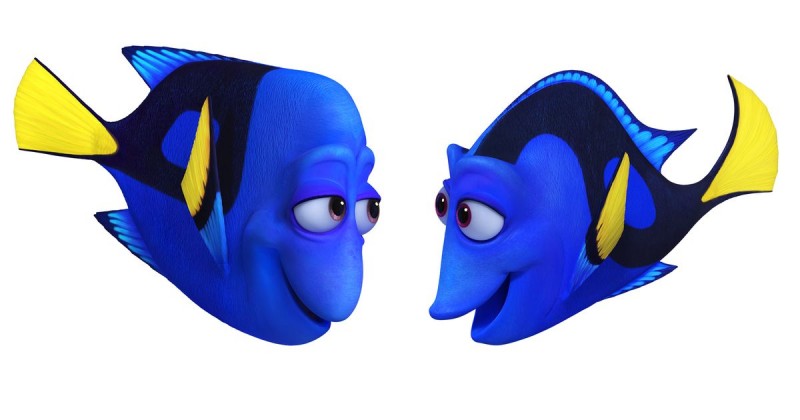 Dory's parents: Charlie and Jenny, caring and cheerful blue surgeons. They have always tried to give their daughter more love and understanding, without restricting her freedom. When their daughter was lost, they were very worried. Outwardly, Dory is just a copy of her father and mother. Charlie and Jenny gave their voices during dubbing by Andrei Waltz and Elena Solodilina. Dory's parents: Charlie and Jenny, caring and cheerful blue surgeons. They have always tried to give their daughter more love and understanding, without restricting her freedom. When their daughter was lost, they were very worried. Outwardly, Dory is just a copy of her father and mother. Charlie and Jenny gave their voices during dubbing by Andrei Waltz and Elena Solodilina.
Hlup and Laster(sea lions)
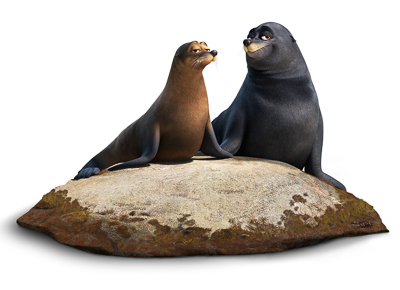 Hlup and Laster are a couple of the coolest sea lions, a parody of gangsters from Guy Ritchie films by his manner of speaking and his whole behavior. But unlike their prototypes, they are quite peaceful, although they can sometimes make a lot of noise because of the nonsense. The following actors sounded these funny and in their own way charismatic sea animals: Khlyupa - Vladimir Antonik, Laster - Denis Nekrasov. Hlup and Laster are a couple of the coolest sea lions, a parody of gangsters from Guy Ritchie films by his manner of speaking and his whole behavior. But unlike their prototypes, they are quite peaceful, although they can sometimes make a lot of noise because of the nonsense. The following actors sounded these funny and in their own way charismatic sea animals: Khlyupa - Vladimir Antonik, Laster - Denis Nekrasov.
 Crash is a big wise green male sea turtle. I paint already one and a half hundred years. He has a funny son - the little turtle Prisk. An impressive life experience allows the turtle to never bother about trifles and constantly be in a relaxed state. The love of life passed on to his son. Voiced by a turtle Igor Balalaev. Crash is a big wise green male sea turtle. I paint already one and a half hundred years. He has a funny son - the little turtle Prisk. An impressive life experience allows the turtle to never bother about trifles and constantly be in a relaxed state. The love of life passed on to his son. Voiced by a turtle Igor Balalaev.
Pixar studio took 13 years to mature on the release of the sequel to the adventures of the inhabitants of the coastal waters of America "Finding Nemo". The clown fish Nemo himself grew up and did not get into alterations anymore, now the plot of the cartoon is focused on the blue surgeon Dory, who in the first part helped to return the orange fish to her father.
The premiere of “Finding Dory” will take place in the summer, and then Disney and Pixar Studios decided to remind viewers of old characters and introduce them to new ones.
Dory, blue surgeon
Suffering in memory failures, which is compensated by inexhaustible optimism. After the adventures in the first part of the cartoon, Dory remained to live near Marlin and Nemo. Once a blue fish remembered that she had parents. Her friends help her to remember important details for the search. Periodically, Dory forgets who she is looking for, but she still has to rediscover her past. In parallel with the self-identification character Dory will gain self-esteem.

Nemo and Marlin, clown fish
After the dangers of adventure, Nemo passed a year, the clownfish became an ordinary teenager: he lives with his father Marlin and attends an underwater school. Nemo's character is still courageous and open. When Dory decides to go across the ocean in search of a home, Nemo is the first to offer her help. Father Nemo first perceives the idea of Dory with skepticism - he remembers very well how difficult his journey across the ocean was in search of his son. But loyalty to her friend takes her, because it was Dory who helped him get Nemo back. Marlin knows firsthand what it is like to be left without a family, and, having conquered skepticism, he sets off to help Dory.

Hank, octopus
Hank lost one of the tentacles, so he is a Seminog. The character, like Marlin, has problems with a sense of humor, but he is a real expert on the part of escapes and disguises, as he can easily take on any appearance. Once in the Marine Life Institute, Dory meets Hank first, but the octopus is not looking for friends. He has a goal: to get into the truck, which will take him to another aquarium, located in Cleveland. According to the octopus, there he will finally be able to enjoy the coveted solitude.

Fate whale shark
By virtue of its size, Destiny is distinguished by its rare clumsiness, but it has a kind heart. When Dory meets her at the Institute, it turns out that they are old acquaintances. Moreover, it turns out that this whale shark is also able to speak in Chinese, and perhaps it was she who taught this to Dory.

Bailey beluga
Bailey also lives in the Institute. He is sure that he is imperfect, since his part of the brain supposedly does not work for echolocation. However, the professors of the Institute did not find any deviations from Bailey. Shark Fate could not explain to Bailey that he was fine. It seems that only Dory will do it.
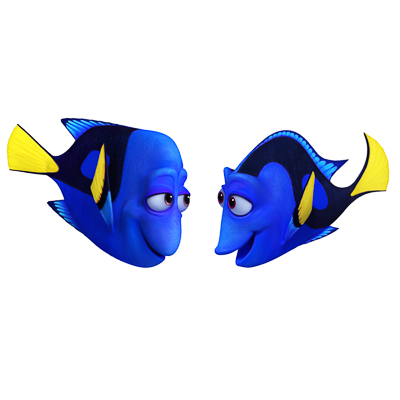
Jenny and Charlie, blue surgeons
Dory's parents love their daughter very much and are ready for everything for her. They defended it and prepared for life in the ocean, teaching everything that a small fish with memory lapses could do. Optimism Dory clearly inherited from her mother, who knows how to wrap any unpleasant situation as a joke. For Charlie, nothing is more important than teaching his daughter the rules of life in the ocean, but he also loves to fool around.
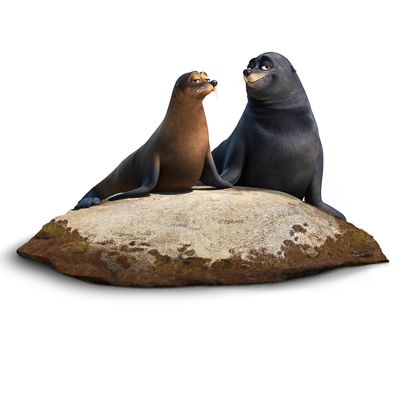
Hlup and Laster, sea lions
Differ outrageous laziness. Often bask in the sun on a stone near the Institute of Marine Life. Sea lions do not like being bothered during their midday sleep, but when other characters had to disturb them, it turned out that Hlyup and Laster were grumbling, but harmless.
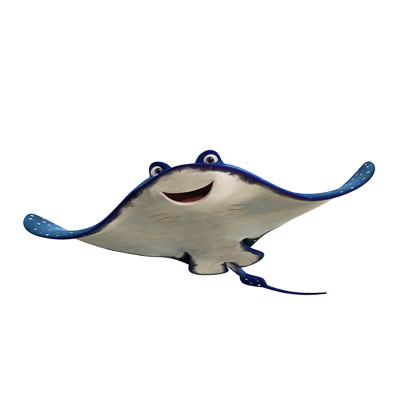
Mr. Skat, skat
Produced by Graham Walters, Ginko Gotoch, John Lasseter Translator Olga Voeikova Dubbing Director Lyudmila Demyanenko Installation David Ian Salter Dubbed actors Jan Tsapnik, Elena Shulman, Fyodor Mashanov, and also Composer Thomas Newman Writers Andrew Stanton, Bob Peterson, David Reynolds Operators Sharon Calahan, Jeremy Laski, Jeric Cleland Artist Ralph Eggleston Do you know that
- The cartoon "Finding Nemo" is dedicated to the Pixar animator G. McQueen.
- The painstaking drawing of sea water with glare of sunlight on fish scales greatly slowed down frame processing. On a fragment of a picture with a duration of 1/24 second it could take 4 days.
- Since most of the plot takes place in the underwater world, before starting work on the picture, the whole team visited the aquarium and listened to lectures on ichthyology.
- To make the facial expression of fish more expressive, the animators carefully studied the emotions of dogs.
- The interior of the dental office was designed following the example of a real treatment room located in the building of the Pixar studio.
- In the scene of a journey riding a tortoise in the background several hundred smaller tortoises are drawn.
- In order not to make a panicker out of Marlin, the director decided to add to the plot a story about the death of his wife, Mama Nemo. So the viewers of the picture became clear the reason for excessive custody.
- The number of A-113 is applied to the dentist’s camera. These numbers are repeated in all Pixar paintings. They mean the number of the university audience in which the studio's animators work.
- The film “Finding Nemo” entered the top ten best animated films in the history of cinema.
More facts (+6)
Mistakes in the cartoon
- Being at the age of 150, Crash claims that it is still quite a bit. In reality, not a single sea turtle lives for more than 100 years, unlike its land relatives.
- When Marlin and Dory enter the whale's mouth, they are advised to stay close to the back of the throat in order to fly through the airways. In fact, the whale's digestive and respiratory systems are related to each other.
- When Nemo is taken out of the aquarium, there is a zipper on the dentist’s bag. In the next scene there is no lightning.
- Bruce’s mask during the pursuit of Marlin and Dory is constantly changing its location, sometimes right or left.
- The screws on the boat should rotate in different directions, and they move in the same direction.
- Nigel has nostrils, although these pelicans do not have them.
- Mr. Ray was deprived of male organs (hooks).
- The water level in the bag, thrown into the ocean, should be in line with the surface of the reservoir.
More mistakes (+5)
Plot
Caution, the text may contain spoilers!
In the waters of the Barrier Reef, clown fish Marlin and Coral happily await replenishment. Family plans do not come true. A terrible predator kills a young mother and eats all offspring. Only one egg manages to survive. The baby born Marlin calls Nemo. Since childhood, Nemo is different from others. Because of the attack of barracuda, one of its fin is smaller and weaker than the second. Babies are often teased at school. Low self-esteem does not give rest, and Nemo decides to prove his abuser that he can swim no worse than others. Clown swims into the open sea, where he is quickly grabbed by a scuba diver. The agitated father rushes to the aid of his only son, but he goes astray. Then Marlin decides to find Nemo on his own. To his team, he calls the blue Dory. Despite the loss of memory, the fish helps in the search well. She sees the inscription "Sydney. Australia "on the fallen mask. The company immediately decides to move in this direction. On their way, Marlyn and Dory meet many dangers and not less than those willing to help. Almost the entire ocean is looking for Nemo. The little clown meanwhile bravely tries to get out of the aquarium in the dentist’s office. The patient of the dentist Darla comes to the rescue. The girl flushes Nemo in the toilet, giving him freedom. After swimming into the open water, the baby soon reunites with his father. In the final scene on the surface of the ocean, all the inhabitants of the aquarium are splashing merrily.
|



 Fate is a peaceful whale shark, a patient of the same California medical center. Dory's old friend, but about her the main character has only fragmentary memories. The shark is experiencing difficulties - it cannot swim straight and therefore feels clumsy. In the clinic, she will certainly have to recover from her illness. Sophia Anufrieva voiced her.
Fate is a peaceful whale shark, a patient of the same California medical center. Dory's old friend, but about her the main character has only fragmentary memories. The shark is experiencing difficulties - it cannot swim straight and therefore feels clumsy. In the clinic, she will certainly have to recover from her illness. Sophia Anufrieva voiced her. Hank, a red octopus with cold blue eyes, is just a terrible character, although he is very smart. He can never restrain himself from talking to anyone. Oddly enough for a marine inhabitant, Hank is a big coffee lover. And he is very freedom-loving. Despite the harsh appearance, in the shower he is just a cutie. Sergey Chikhachev gave him his voice.
Hank, a red octopus with cold blue eyes, is just a terrible character, although he is very smart. He can never restrain himself from talking to anyone. Oddly enough for a marine inhabitant, Hank is a big coffee lover. And he is very freedom-loving. Despite the harsh appearance, in the shower he is just a cutie. Sergey Chikhachev gave him his voice.  Dory's parents: Charlie and Jenny, caring and cheerful blue surgeons. They have always tried to give their daughter more love and understanding, without restricting her freedom. When their daughter was lost, they were very worried. Outwardly, Dory is just a copy of her father and mother. Charlie and Jenny gave their voices during dubbing by Andrei Waltz and Elena Solodilina.
Dory's parents: Charlie and Jenny, caring and cheerful blue surgeons. They have always tried to give their daughter more love and understanding, without restricting her freedom. When their daughter was lost, they were very worried. Outwardly, Dory is just a copy of her father and mother. Charlie and Jenny gave their voices during dubbing by Andrei Waltz and Elena Solodilina.  Hlup and Laster are a couple of the coolest sea lions, a parody of gangsters from Guy Ritchie films by his manner of speaking and his whole behavior. But unlike their prototypes, they are quite peaceful, although they can sometimes make a lot of noise because of the nonsense. The following actors sounded these funny and in their own way charismatic sea animals: Khlyupa - Vladimir Antonik, Laster - Denis Nekrasov.
Hlup and Laster are a couple of the coolest sea lions, a parody of gangsters from Guy Ritchie films by his manner of speaking and his whole behavior. But unlike their prototypes, they are quite peaceful, although they can sometimes make a lot of noise because of the nonsense. The following actors sounded these funny and in their own way charismatic sea animals: Khlyupa - Vladimir Antonik, Laster - Denis Nekrasov. Crash is a big wise green male sea turtle. I paint already one and a half hundred years. He has a funny son - the little turtle Prisk. An impressive life experience allows the turtle to never bother about trifles and constantly be in a relaxed state. The love of life passed on to his son. Voiced by a turtle Igor Balalaev.
Crash is a big wise green male sea turtle. I paint already one and a half hundred years. He has a funny son - the little turtle Prisk. An impressive life experience allows the turtle to never bother about trifles and constantly be in a relaxed state. The love of life passed on to his son. Voiced by a turtle Igor Balalaev. 














